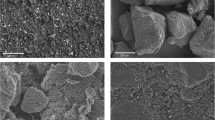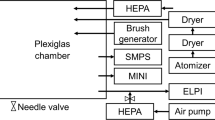Abstract
Mass production of some kinds of carbon nanotubes (CNT) is now imminent, but little is known about the risk associated with their exposure. It is important to assess the propensity of the CNT to release particles into air for its risk assessment. In this study, we conducted aerosolization of a multi-walled CNT (MWCNT) to assess several aerosol measuring instruments. A Palas RBG-1000 aerosol generator applied mechanical stress to the MWCNT by a rotating brush at feed rates ranging from 2 to 20 mm/h, which the MWCNT was fed to a two-component fluidized bed. The fluidized bed aerosol generator was used to disperse the MWCNT aerosol once more. We monitored the generated MWCNT aerosol concentrations based on number, area, and mass using a condensation particle counter and nanoparticle surface area monitor. Also we quantified carbon mass in MWCNT aerosol samples by a carbon monitor. The shape of aerosolized MWCNT fibers was observed by a scanning electron microscope (SEM). The MWCNT was well dispersed by our system. We found isolated MWCNT fibers in the aerosols by SEM and the count median lengths of MWCNT fibers were 4–6 μm. The MWCNT was quantified by the carbon monitor with a modified condition based on the NIOSH analytical manual. The MWCNT aerosol concentration (EC mass base) was 4 mg/m3 at 2 mm/h in this study.










Similar content being viewed by others
References
Birch ME, Cary RA (1996) Elemental Carbon-based method for monitoring occupational exposures to particulate diesel exhaust. Aerosol Sci Technol 25:221–224. doi:10.1080/02786829608965393
Carpenter RL, Pickrell JA, Mokler BV, Yeh HC, DeNee PB (1981) Generation of respirable glass fiber aerosols usinga fluidized bed aerosol generator. Am Ind Hyg Assoc J 42:777–784
Ding L, Stilwell J, Zhang T, Elboudwarej O, Jiang H, Selegue JP et al (2005) Molecular characterization of the cytotoxic mechanism of multiwall carbon nanotubes and nano-onions on human skin fibroblast. Nano Lett 5:2448–2464. doi:10.1021/nl051748o
Endo M (1988) Grow carbon fibers in the vapor phase. Chemtech 18:568–576
Fissan H, Trampe A, Neunman S, Pui DYH, Shin WG (2006) Rationale and principle of an instrument measuring lung deposition area. J Nanopart Res 9:53–59. doi:10.1007/s11051-006-9156-8
Hounam RF (1971) The Konimiser—a dispenser for the continuous generation of dust clouds from milligram quantities of asbestos. Ann Occup Hyg 14:329–335
Kuhlbusch TAJ, Neumann S, Fissan H (2004) Number size distribution, mass concentration, and particle composition of PM1, PM2.5, and PM10 in bag filling areas of carbon black production. J Occup Environ Hyg 1:660–671. doi:10.1080/15459620490502242
Kuhlbusch TAJ, Fissan H (2006) Particle characteristics in the reactor and palletizing areas of carbon black production. J Occup Environ Hyg 3:558–567. doi:10.1080/15459620600912280
Lam CW, James JT, McCluskey R, Hunter RL (2004) Pulmonary toxicity of single-wall carbon nanotubes in mice 7 and 90 days after intratracheal instillation. Toxicol Sci 77:126–134. doi:10.1093/toxsci/kfg243
Li JG, Li WX, Xu JY, Cai XQ, Liu RL, Li YJ et al (2007) Comparative study of pathological lesions induced by multiwalled carbon nanotubes in lungs of mice by intratracheal instillation and inhalation. Environ Toxicol 22:415–421. doi:10.1002/tox.20270
Maynard AD, Baron PA, Foley M, Shevedova AA, Kisin ER, Castranova V (2004) Exposure to carbon nanotube material: aerosol release during the handling of unrefined single-walled carbon nanotube material. J Toxicol Environ Health Part A 67:87–107
Methner MM, Birch ME, Evans DE, Ku B-K, Crouch K, Hoover MD (2007) Identification and characterization of potential sources of worker exposure to carbon nanofibers during polymer composite laboratory operations. J Occup Environ Hyg 4:D125–D130 (Mazzuckelli LF, Editor)
Mitchell LA, Gao J, Wal RV, Gigliotti A, Burchiel SW, McDonald JD (2007) Pulmonary and systemic immune response to inhaled multiwalled carbon nanotubes. Toxicol Sci 1000:203–214. doi:10.1093/toxsci/kfm196
Monteiro-Riviere NA, Nemanich RJ, Inman AO, Wang YY, Riviere JE (2005) Multi-walled carbon nanotube interactions with human epidermal keratinocytes. Toxicol Lett 155:377–384. doi:10.1016/j.toxlet.2004.11.004
Myojo T (1983) A fibrous aerosol generator using a two-component fluidized bed. Ind Health 21:78–89
NIOSH (1999) Method 5040 Issue 3 (Interim) Elemental Carbon (Diesel Exhaust) in NIOSH manual of analytical methods. National Institute of Occupational Safety and Health, Cincinnati, OH
Shvedova AA, Castranova V, Kisin ER, Schwegler-Berry D, Murray AR, Gandelsman VZ et al (2003) Exposurte to carbon nanotube material: assessment of nanotube cytotoxicity using human keratinocyte cells. J Toxicol Environ Health Part A 66:1909–1926
Shvedova AA, Kisin ER, Mercer R, Murray AR, Johnson VJ, Potapovich AI et al (2005) Unusual inflammatory and fibrogenic pulmonary responses to single-walled carbon nanotubes in mice. Am J Physiol Lung Cell Mol Physiol 289:L698–L708. doi:10.1152/ajplung.00084.2005
Tanaka I, Akiyama T (1984) A new dust generator for inhalation toxicity studies. Ann Occup Hyg 28:157–162. doi:10.1093/annhyg/28.2.157
Warheit DB, Laurence BR, Reed KL, Roach DH, Reynolds GAM, Webb TR (2004) Comparative pulmonary toxicity assessment of single-wall carbon nanotubes in rats. Toxicol Sci 77:117–125. doi:10.1093/toxsci/kfg228
Author information
Authors and Affiliations
Corresponding author
Rights and permissions
About this article
Cite this article
Myojo, T., Oyabu, T., Nishi, K. et al. Aerosol generation and measurement of multi-wall carbon nanotubes. J Nanopart Res 11, 91–99 (2009). https://doi.org/10.1007/s11051-008-9450-8
Received:
Accepted:
Published:
Issue Date:
DOI: https://doi.org/10.1007/s11051-008-9450-8




